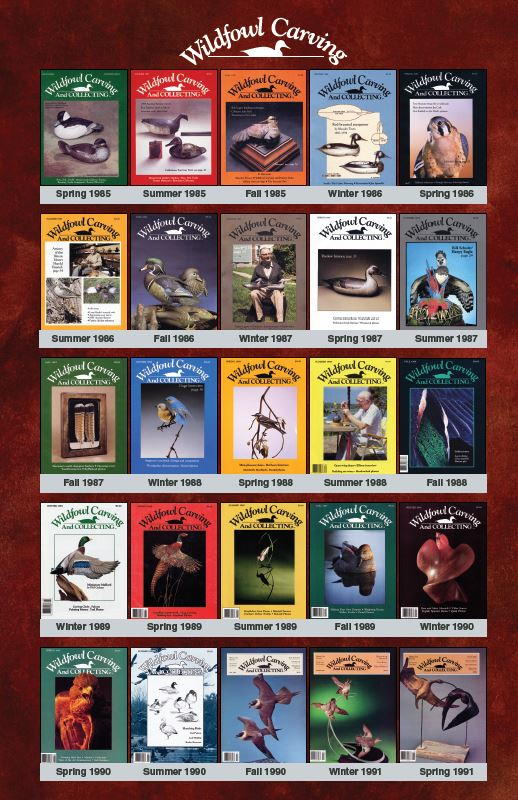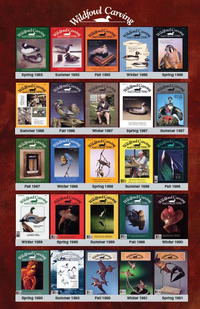Happy Anniversary to Us
It's been 25 years since the first issue of Wildfowl Carving and Collecting Magazine reached eager carvers. It seems like only yesterday.

In the beginning—before the beginning, even—there was a book. The book was How to Carve Wildfowl by Roger Schroeder, which Stackpole Books of Harrisburg, Pennsylvania, published in 1984. The hardcover volume included profiles of nine carvers, among them Larry Barth, Ernie Muehlmatt, John Scheeler, and Gary Yoder. Judith Schnell served as the books editor.
How to Carve Wildfowl was an immediate success and went into a second printing within two months.The third, fourth, and fifth printings quickly followed. Stackpole's David Detweiler, who had been seeking an idea for a specialty magazine for the company to publish, realized the idea had been staring him in the face. Why not wildfowl carving?
"It looked like something worth trying," says Detweiler, who became the new magazine's publisher. Today he is Stackpole's president and CEO.
To edit the new magazine, the company hired Tracy Patterson, a newly minted graduate from Dickinson College in Carlisle.
"I was just out of school, naive, but even I could recognize that this was a once-in-a-lifetime opportunity," says Patterson, who now serves as Stackpole's vice president for creative services and production. "It was exhilarating and terrifying at the same time.We didn't know we couldn't do it. We just put our heads down and did it."
"Right from the beginning, it was going to be a quality magazine," says Schnell, now Stackpole's vice president and publisher.
After the success of How to Carve Wildfowl, she had become the company's de facto carving expert, so Schnell also pitched in on the new project as its editorial consultant. She, Patterson, and Detweiler all logged time on weekends putting together magazine mockups and promotional materials. Soon they had a flyer in the mail, soliciting advance subscriptions to "a source of information, instruction, and illustration for the dedicated carver and collector of North American wildfowl." The price for four quarterly issues was $25.
The two women began attending carving shows to promote the planned magazine. They would set up a table and do their best to talk people into paying for a publication that didn't yet exist. Making the task more difficult was the fact that somebody else had tried to launch a similar magazine a year previously, but they had failed to get it off the ground.
Fortunately, the carving community was eager for such a publication. Charles W. Frank, Jr., the chairman of the Louisiana Wildfowl Carver's Festival and author of Louisiana Duck Decoys and Anatomy of a Waterfowl, even drove all the way from his native state to Harrisburg to drop by the magazine offices and offer his support. He ended up writing an article, a primer on different burning techniques called "Different Stokes," for the premier issue.
Volume one, number one reached subscribers' mailboxes in the spring of 1985. Along with Frank's article, it included a feature about an Ernie Muehlmatt meadowlark, a wood duck reference article, Roger Schroeder's piece about the Long Island decoys in the collection of George Combs, Jr., an interview with carver Joy Yox, some beautiful color photos of a green-winged teal sculpture by Robert K. Searles, and other features. It was a strong beginning, but the magazine improved as it went on, as its editors recruited more and more of its authors and subjects from the ranks of the world's top carvers.
The past quarter century has naturally seen many changes, as the largely black-and-white early issues transformed into the full-color magazine of today. In 1986, Cathy Hart took over the job as editor, a post she held through the Spring 2001 issue.The editors since have been Candice Tennant (who became Candice Derr when she got married), Daniel Marsteller, Bill Einsig, and Tom Huntington. In 1999, the magazine dropped "collecting" from the title so it could focus more on the how-to aspect of carving.
"Collecting was never as much a part of the magazine as we thought it would be," says Detweiler. "It was a magazine for carvers."
That's what it remains today, and Wildfowl Carving Magazine continues to take pride in providing a forum for the artists who continue to push wildfowl carving to new heights. As the magazine's first 100 covers, on display in a special section in the Spring 2010 issue, demonstrate, Wildfowl Carving's tradition of excellence has lasted for 25 years. We intend to continue it for the next 25 and beyond. Happy anniversary to us!
This article is from the Spring 2010 issue. For more information on our issues, check out our issues page.
Read NextMaking Feet



